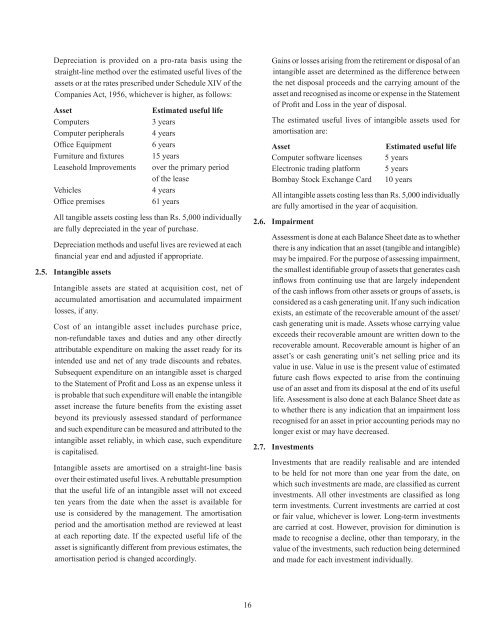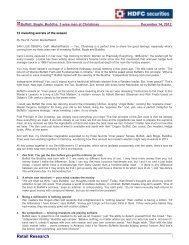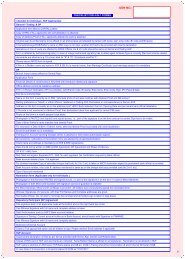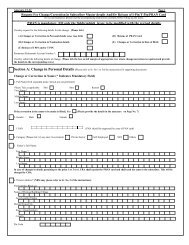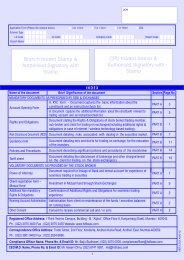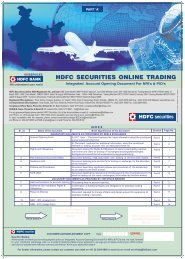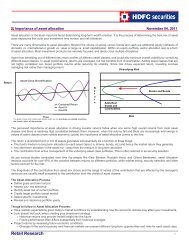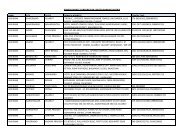Annual Report 2012-2013 - HDFC Bank
Annual Report 2012-2013 - HDFC Bank
Annual Report 2012-2013 - HDFC Bank
Create successful ePaper yourself
Turn your PDF publications into a flip-book with our unique Google optimized e-Paper software.
Depreciation is provided on a pro-rata basis using thestraight-line method over the estimated useful lives of theassets or at the rates prescribed under Schedule XIV of theCompanies Act, 1956, whichever is higher, as follows:AssetComputersComputer peripheralsOffice EquipmentFurniture and fixturesLeasehold ImprovementsVehiclesOffice premisesEstimated useful life3 years4 years6 years15 yearsover the primary periodof the lease4 years61 yearsAll tangible assets costing less than Rs. 5,000 individuallyare fully depreciated in the year of purchase.Depreciation methods and useful lives are reviewed at eachfinancial year end and adjusted if appropriate.2.5. Intangible assetsIntangible assets are stated at acquisition cost, net ofaccumulated amortisation and accumulated impairmentlosses, if any.Cost of an intangible asset includes purchase price,non-refundable taxes and duties and any other directlyattributable expenditure on making the asset ready for itsintended use and net of any trade discounts and rebates.Subsequent expenditure on an intangible asset is chargedto the Statement of Profit and Loss as an expense unless itis probable that such expenditure will enable the intangibleasset increase the future benefits from the existing assetbeyond its previously assessed standard of performanceand such expenditure can be measured and attributed to theintangible asset reliably, in which case, such expenditureis capitalised.Intangible assets are amortised on a straight-line basisover their estimated useful lives. A rebuttable presumptionthat the useful life of an intangible asset will not exceedten years from the date when the asset is available foruse is considered by the management. The amortisationperiod and the amortisation method are reviewed at leastat each reporting date. If the expected useful life of theasset is significantly different from previous estimates, theamortisation period is changed accordingly.Gains or losses arising from the retirement or disposal of anintangible asset are determined as the difference betweenthe net disposal proceeds and the carrying amount of theasset and recognised as income or expense in the Statementof Profit and Loss in the year of disposal.The estimated useful lives of intangible assets used foramortisation are:AssetComputer software licensesElectronic trading platformBombay Stock Exchange CardEstimated useful life5 years5 years10 yearsAll intangible assets costing less than Rs. 5,000 individuallyare fully amortised in the year of acquisition.2.6. ImpairmentAssessment is done at each Balance Sheet date as to whetherthere is any indication that an asset (tangible and intangible)may be impaired. For the purpose of assessing impairment,the smallest identifiable group of assets that generates cashinflows from continuing use that are largely independentof the cash inflows from other assets or groups of assets, isconsidered as a cash generating unit. If any such indicationexists, an estimate of the recoverable amount of the asset/cash generating unit is made. Assets whose carrying valueexceeds their recoverable amount are written down to therecoverable amount. Recoverable amount is higher of anasset’s or cash generating unit’s net selling price and itsvalue in use. Value in use is the present value of estimatedfuture cash flows expected to arise from the continuinguse of an asset and from its disposal at the end of its usefullife. Assessment is also done at each Balance Sheet date asto whether there is any indication that an impairment lossrecognised for an asset in prior accounting periods may nolonger exist or may have decreased.2.7. InvestmentsInvestments that are readily realisable and are intendedto be held for not more than one year from the date, onwhich such investments are made, are classified as currentinvestments. All other investments are classified as longterm investments. Current investments are carried at costor fair value, whichever is lower. Long-term investmentsare carried at cost. However, provision for diminution ismade to recognise a decline, other than temporary, in thevalue of the investments, such reduction being determinedand made for each investment individually.16


